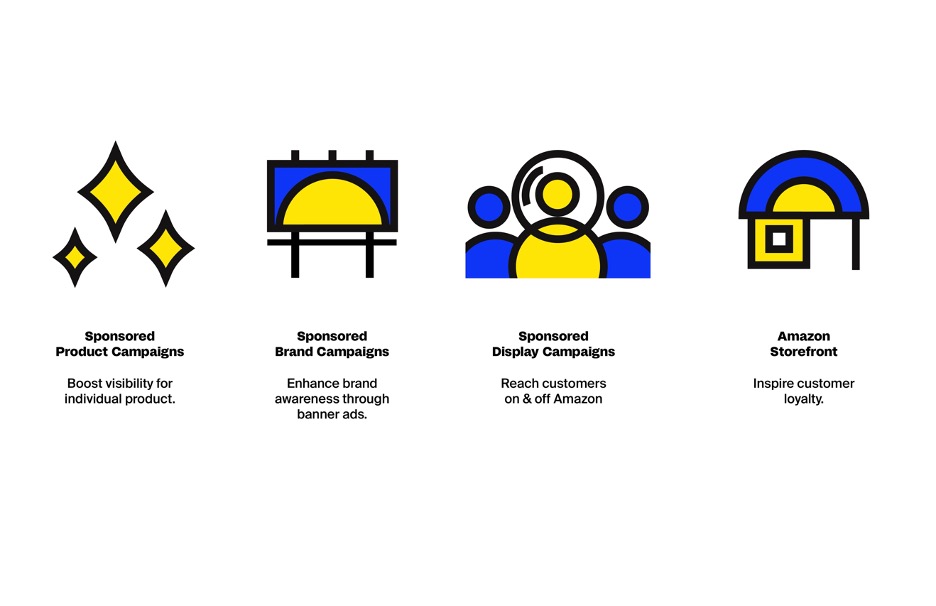It is no secret that Amazon has grown to be the largest marketplace in the world, now with 300+ million active accounts in 180+ countries. Amazon has an impressive 54% market share of product searches. In other words, Amazon, not Google, is the most popular e-commerce search engine in the world. When it comes to the purchase phase of the customer journey, Amazon advertising has a clear advantage. Amazon’s path to conversion is clear and simple as consumers are already familiar with Amazon shipping fees, Amazon’s return policy, and the entire checkout process. The answer is the same every time.
Amazon converts 6x higher than the top ten retail sites in the United States. Businesses of all sizes thrive on Amazon. In fact, the main takeaway from this ultimate guide to success on Amazon should be that Amazon is a conversion machine. Whereas Google profits when users click an ad, Amazon profits when customers convert. For this reason, Amazon’s A9 algorithm is tailored such that the primary focus is conversions. Amazon customers are typically low-funnel shoppers. Customers will often first do all their research on Google, but then come to Amazon when it is time to actually make their purchase. As Amazon customers are ready to convert, it is more important than ever before for brands to be on Amazon and to show up first through Amazon Advertising.
Get Started with Selling on Amazon
Once a brand has been approved to sell on Amazon, it will be given access to Amazon Seller Central. Brands can list items, manage inventory, track orders, and start advertising all through Amazon Seller Central. The initial setup will also include setting up a company bank account and tax information, assigning shipping templates, and applying for Amazon’s brand registry when applicable.
Sellers have the option to manually list items on Amazon, or to use one of the many category-specific inventory feeds that Amazon provides to mass upload multiple items at the same time. While listing items, keep in mind that Amazon’s version of an SKU is called an ASIN, or an Amazon Standard Identification Number. For every SKU you upload to Amazon, it will automatically be assigned a unique ASIN.
It is important to note that Amazon prioritizes showing variety for their search queries. New listings and variations tend to show up high organically in search rankings, so it is a good best practice to streamline adding new items. Think of implementing bundles or different pack sizes to introduce additional variations if your company is limited with SKUs.
FBA vs. FBM
One of the early decisions an e-commerce brand looking to sell on Amazon will need to make is whether they plan to sell as Fulfilled By Amazon (FBA), or as Fulfilled By Merchant (FBM). The biggest difference between these two fulfillment methods is that with FBA, the seller ships inventory to Amazon’s warehouse, and Amazon is responsible for the picking, packing, and shipping of all orders. With FBM, the seller themselves is responsible for all shipping-related functions. Sellers looking to focus strictly on strategy may lean closer to FBA, whereas sellers who need more control over their inventory might choose FBM. There are benefits to both methods and this decision typically depends on individual business needs.
Types of Amazon Advertising
When it comes to selling on Amazon, the name of the game is to take up all of the real estate. For all major relevant keywords, brands should aim to be the obvious choice by optimizing their listings to show up first and show up often. In order to be successful on Amazon, it is crucial to have a strong Amazon advertising strategy. A well-tuned Amazon advertising strategy should increase organic Amazon rankings as well. Take advantage of Amazon’s arsenal of advertising formats and targeting options to achieve the greatest ROI on Amazon.

Sponsored Products
Sponsored Product ads are a pay-per-click (PPC) solution that helps drive traffic directly your product pages. Similar to Google Ads, sellers can select the listings they want to advertise and can toggle between a variety of different targeting options to increase sales and visibility. Sponsored Product ads are by far the most popular ad format seen on Amazon. Be sure to familiarize yourself with Amazon’s reporting functions to be able to measure the impact of your Sponsored Product campaigns.
While setting up Sponsored Product ads, advertisers can choose between manual and automatic keyword targeting options:
Automatic Targeting
Automatic targeting is a great option for new sellers and experienced sellers alike. For those who are new to Amazon’s Marketplace, Automatic Targeting allows sellers to get started with advertising without necessarily knowing exactly what keywords they need to bid on. Automatic Targeting is also a proven method to optimize existing Amazon advertising strategies. Mine through the search terms gathered by Amazon through Automatic Targeting campaigns to harvest new, high-intent keywords when setting up Manual Targeting campaigns.
Manual Targeting
Amazon’s Manual Targeting campaigns follow a classic keyword bidding structure offering broad, phrase, and exact keyword matches. Amazon sellers can choose the listings they would like to advertise and set up corresponding keywords to bid on. For sellers who already know what keywords they need to bid on, Manual Targeting is a great option.
Product Targeting
The third option for advertisers to increase their ROAS on Amazon is to implement Product Targeting. Unlike keyword targeting, advertisers have the option to target products on Amazon directly. Sellers can target competing product, complimentary product, or their own products. This gives sellers the unique opportunity to convert customers at the lowest stage of the funnel. Additionally, brands who advertise on their own listings are actively preventing other brands from taking up that same real estate. Keep in mind that in order to set up Product Targeting campaigns, you will need to know the ASINs you are looking to target. Think of product targeting like all out warfare.

Sponsored Brands
Amazon sellers can set up sponsored brand ads that lead customers to individual product pages, or to a page on their Amazon Storefront. Sponsored Brand ads are designed to drive brand awareness through banner ads shown at the top of Amazon search results with custom headlines. This is your chance to highlight your brand’s competitive advantage and display examples of your product selection. Sponsored Brand ads are shown on both desktop and mobile. It is important to note that sponsored brand ads are only available to sellers enrolled in Amazon Brand Registry.
Sponsored Display
Amazon’s display advertising options allow sellers to reach customers on and off Amazon. Sponsored Display ads on Amazon are a cost-per-click (CPC) solution where advertisers set their daily bid and budget. These dynamically generated ads are served to audiences that are created based on Amazon shopping interest and buyer history. On average, advertisers who implement Sponsored Display ads on Amazon see up to 82% of their sales driven by new-to-brand customers. Remember to experiment with all advertising options on Amazon to find what works best for your brands.
Amazon Storefront
Sellers can create their very own Amazon Storefront, or a unique web store landing page, complete with their own URL, branding, and product selection. It is important to keep in mind the role of performance marketing in a digital first advertising world. Each brand’s values, reputation and trustworthiness should be exemplified by the Amazon Storefront. Setup your own multi-page store to inspire customer loyalty and feature your product portfolio. Designing an Amazon Storefront requires no coding experience and the interface to do so is extremely user-friendly. Choose from a selection of predesigned templates, upload images and organize your landing pages to showcase your top listings. Be sure to keep your Amazon Storefront up-to-date with new, in stock products and to update based on seasonality.
Check out our tailored list of the most impressive Amazon Storefronts here:
Biossance
Biossance does a great job both incorporating video into their Amazon Storefront as well as leveraging influencer lifestyle images to boost brand credibility.
Sonos
We’re all ears while leader in home entertainment Sonos takes advantage of the Amazon Storefront to tell the story behind their brand and highlight their unique value proposition.
HIPPEAS
HIPPEAS stands out by incorporating dynamic Amazon Storefront templates to showcase active listings relevant to the customers search history. Focus on designing a conversion-first storefront by including product listings with the add to cart option directly on the homepage.
Top 10 Tips To Be Successful On Amazon
- Images & Videos: Every product listing should have at least 3 high-quality images and 1 product video.
- New Listing Strategy: Work with your marketing experts to strategize how to streamline adding new item variations ideally via a product feed.
- Keyword Optimization: Be resourceful with your keyword use in listing titles, bullet points, search terms, and item descriptions.
- Amazon Brand Registry: For brand owners, applying for Amazon Brand Registry is a crucial step to be able to set up Sponsored Brand ads, Sponsored Display ads, and the Amazon Storefront.
- A+ Content: Formerly known as Enhanced Brand Content. This feature is also only available to brand owners but is a great way to boost rankings in Amazon’s A9 algorithm and to showcase additional product benefits.
- Amazon Advertising: Understand your goals and diversify your Amazon Advertising strategy to achieve the greatest ROI on Amazon.
- Metrics: Pay attention to your order defect rate, cancellation rate, and delivery metrics to ensure your seller account is above expected performance targets required to sell on Amazon.
- Prime: Once a fulfillment method has been decided upon, work with your marketing experts to understand how to apply for the prime badge.
- Be Resilient: Amazon is constantly introducing new advertising features and tools and it is our job as brand owners to stay ahead of these changes. Be curious and refer back to the seller forums to understand the impact of planned changes.
- Reviews: Gather and engage with both product and seller reviews. Leverage feedback and celebrate the positive reviews!
Amazon Custom
Brands that specialize in selling personalized products of all kinds have the unique opportunity to sell on Amazon through Amazon Custom. Think embroidered t-shirts, engraved trophies, or any type of custom gift. Customers have the ability to choose their customization options and enter their custom text directly on Amazon for the seller to process. Keep in mind Amazon’s strict delivery speed requirements when deciding if it makes sense to sell your custom product on Amazon. Also, an Amazon Custom seller must choose FBM as their fulfillment method and conduct all personalization in-house. On the item setup side, a seller should upload their listings as usual with the additional step of uploading a customizations feed.
Conclusion
Amazon is projected to remain a growth leader as they continue to accelerate into the digital marketing space in 2022. Amazon is a conversion machine that capitalizes on a purchase-ready audience. As a shopping hub that is more in tune with customer behavior than any other platform, Amazon provides unparalleled insight and enormous advertising opportunities for brands of all sizes. Need help getting started? Reach out to our team of Amazon Specialists to discuss your Amazon Advertising goals and how to increase sales.






